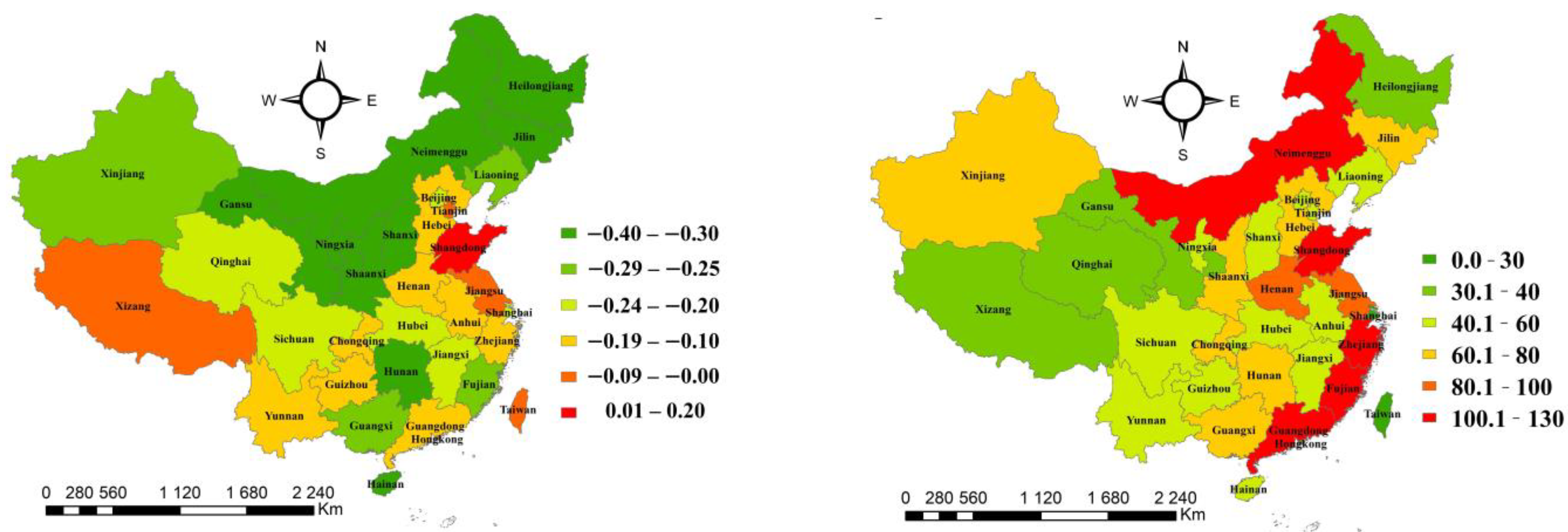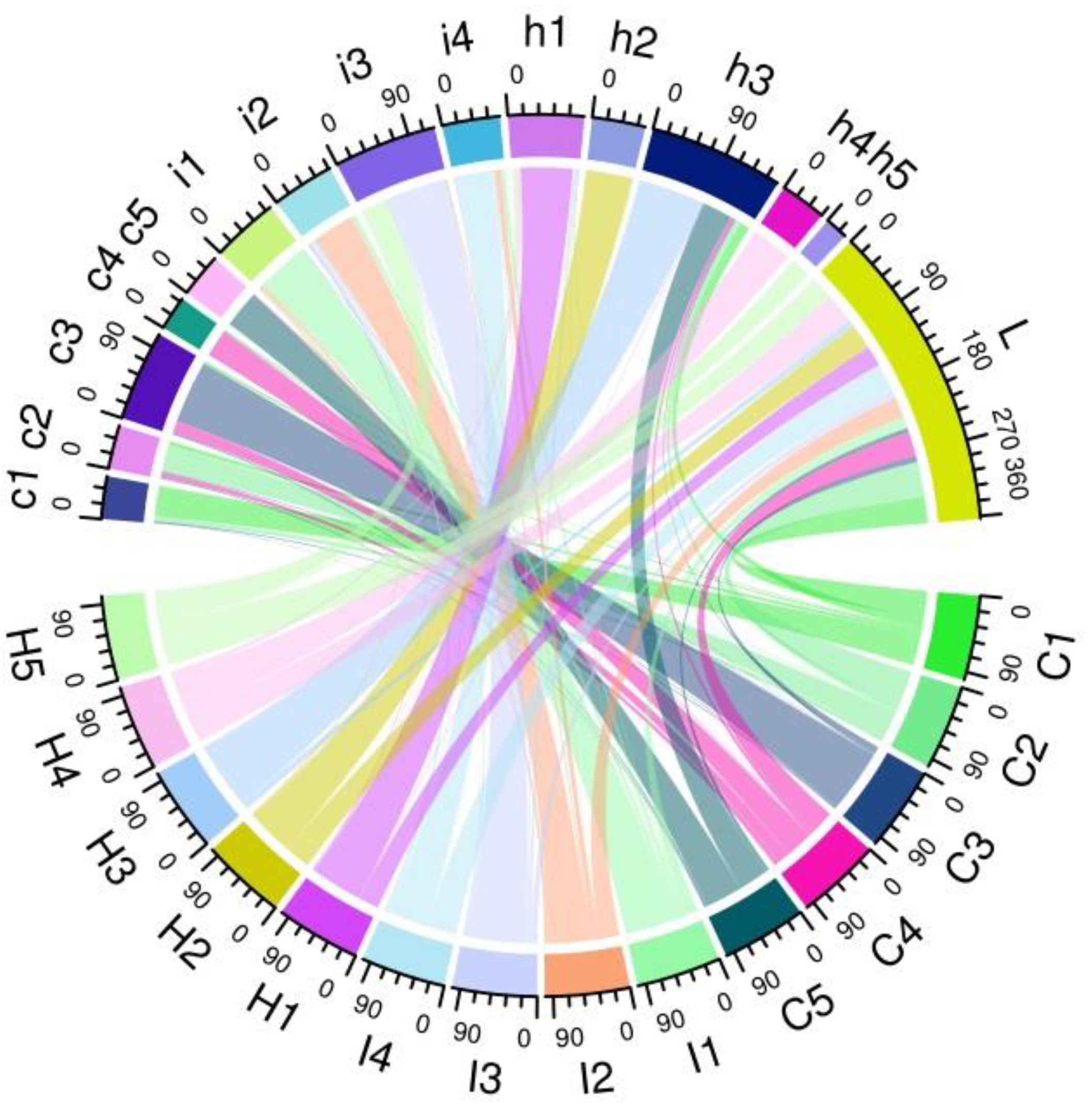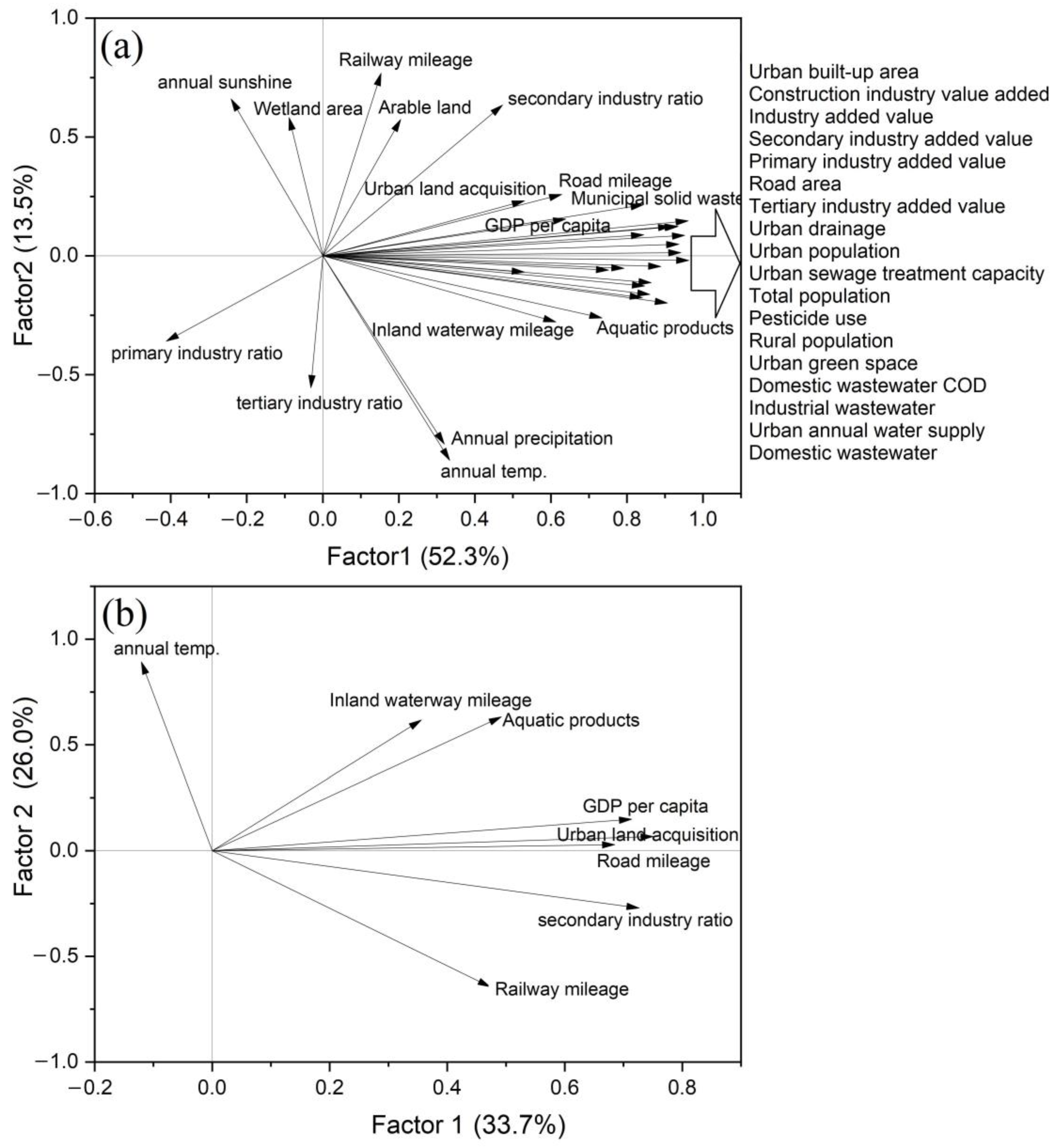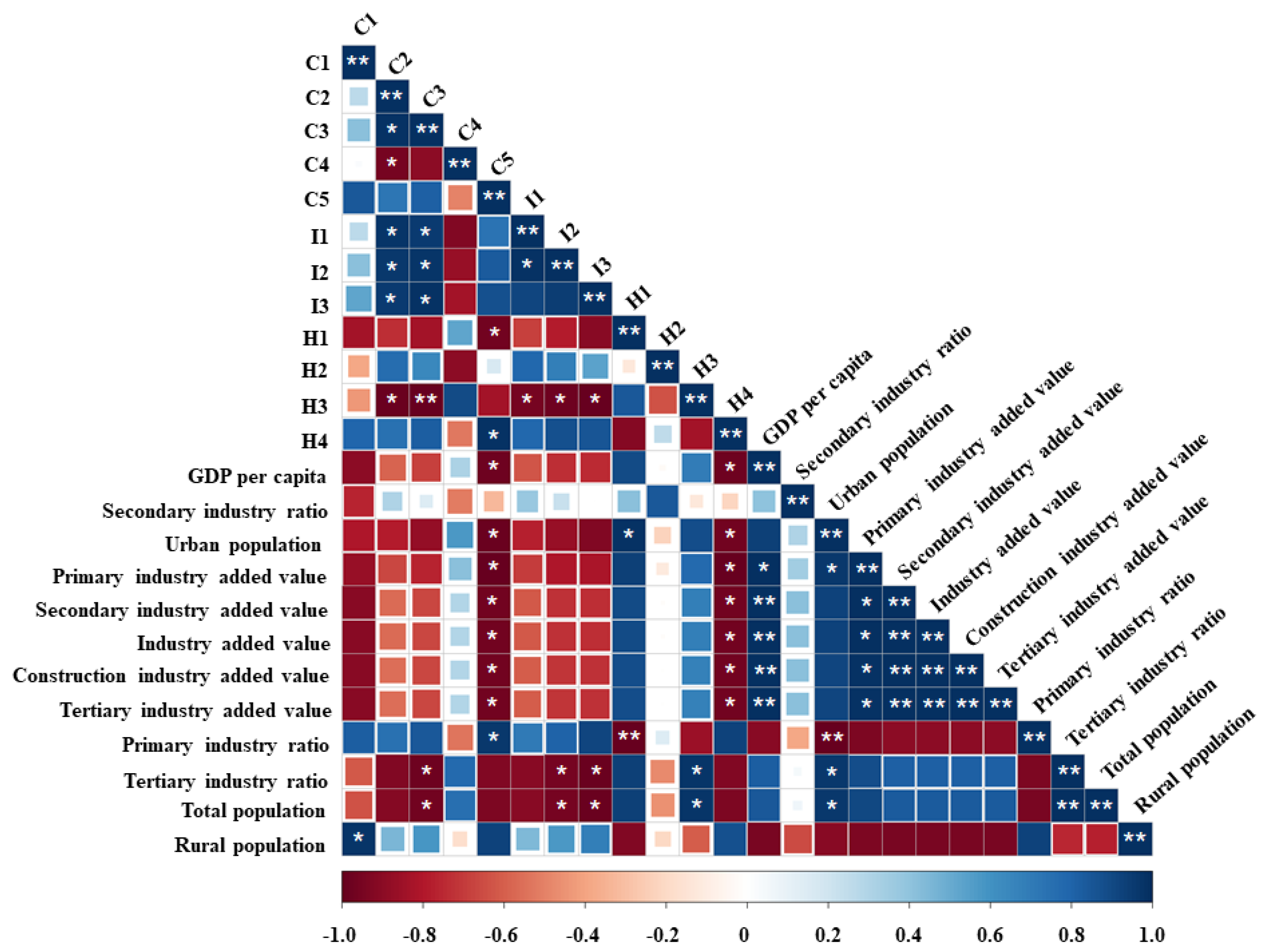Socioeconomic and Climate Effects on Changes in Wetlands in China during a Three-Decade Period of Rapid Growth
Abstract
1. Introduction
2. Materials and Methods
2.1. Study Site
2.2. Data Collection
2.3. Data Analysis
3. Results
3.1. Feature of Wetland Change
3.1.1. Changes in Overall Wetland Areas
3.1.2. Change in Types of Wetlands
3.2. Analysis of Driving Factors for Wetland Change
3.2.1. Driving Factors for Changes in a Whole Wetland Area
3.2.2. Driving Factors for the Changes in Wetland Types
4. Discussion
4.1. Climate Factors Affect Changes in Wetlands
4.1.1. Changes in Wetland Area Influenced by Climate Factors
4.1.2. Changes in Wetland Types Influenced by Climate Factors
4.2. Effect of Socioeconomic Factors on Changes in Wetlands
4.2.1. Changes in Wetland Area Influenced by Socioeconomic Factors
4.2.2. Changes in Wetland Types Influenced by Socioeconomic Factors
4.3. Implications and Suggestions for Wetland Conservation in China
- (1)
- Measures should be taken to mitigate the impacts of climate change on wetlands. The effects of climate change, such as rising temperature, were shown to be the leading factors impacting wetlands change in China. Thus, efforts to reduce greenhouse gas emissions and implement adaptation strategies to protect wetlands from the effects of climate change should be prioritized.
- (2)
- There is a need to balance economic development and wetland conservation. While economic growth is essential, it should not come at the expense of wetland loss. Policies and regulations that encourage sustainable development and protect wetlands should be implemented. This could include measures such as zoning regulations that restrict development in wetland areas, and incentives for businesses that implement environmentally friendly practices.
- (3)
- Wetland restoration and wetland creation should be actively promoted. This can include the restoration of degraded wetlands and the creation of new wetlands, particularly in urban areas where wetlands are often lost due to urbanization in China. This will not only help protect biodiversity and ecosystem services but also provide opportunities for eco-tourism and other economic activities.
- (4)
- More comprehensive and accurate data on changes in wetlands in China are needed in order to better understand the dynamics of wetland change and inform conservation efforts. Long-term monitoring programs and remote sensing, and other advanced technologies might be used to gather data and provide insights into the state of wetlands in China.
4.4. Limitations of the Study and Future Research Needs
5. Conclusions
Supplementary Materials
Author Contributions
Funding
Data Availability Statement
Conflicts of Interest
References
- Ramachandra, T.V.; Rajinikanth, R.; Ranjini, V.G. Economic Valuation of Wetlands. J. Environ. Biol. 2005. [Google Scholar]
- Meng, W.; He, M.; Hu, B.; Mo, X.; Li, H.; Liu, B.; Wang, Z. Status of Wetlands in China: A Review of Extent, Degradation, Issues and Recommendations for Improvement. Ocean Coast Manag. 2017, 146. [Google Scholar] [CrossRef]
- Davidson, N.C. Wetland Losses and the Status of Wetland-Dependent Species. In The Wetland Book; Finlayson, C., Milton, G., Prentice, R., Davidson, N., Eds.; Springer: Berlin/Heidelberg, Germany, 2016; pp. 1–14. [Google Scholar]
- Fraissinet, M.; Ancillotto, L.; Migliozzi, A.; Capasso, S.; Bosso, L.; Chamberlain, D.E.; Russo, D. Responses of Avian Assemblages to Spatiotemporal Landscape Dynamics in Urban Ecosystems. Landsc. Ecol. 2023, 38, 293–305. [Google Scholar] [CrossRef]
- Bian, H.; Li, W.; Li, Y.; Ren, B.; Niu, Y.; Zeng, Z. Driving Forces of Changes in China’s Wetland Area from the First (1999–2001) to Second (2009–2011) National Inventory of Wetland Resources. Glob. Ecol. Conserv. 2020, 21. [Google Scholar] [CrossRef]
- Kirwan, M.L.; Megonigal, J.P. Tidal Wetland Stability in the Face of Human Impacts and Sea-Level Rise. Nature 2013, 504, 53–60. [Google Scholar] [CrossRef]
- Liu, J.; Tian, H.; Liu, M.; Zhuang, D.; Melillo, J.M.; Zhang, Z. China’s Changing Landscape during the 1990s: Large-Scale Land Transformations Estimated with Satellite Data. Geophys. Res. Lett. 2005, 32, 1–5. [Google Scholar] [CrossRef]
- Zeng, H.; Gao, Q.; Chen, X.; Li, G. Changes of the Wetland Landscape in Shenzhen City from 1988 to 2007 and the Driving Force Analysis. Shengtai Xuebao/Acta Ecologica Sinica 2010, 30, 2706–2714. [Google Scholar]
- Guo, M.; Li, J.; Sheng, C.; Xu, J.; Wu, L. A Review of Wetland Remote Sensing. Sensors 2017, 17, 777. [Google Scholar] [CrossRef]
- Turner, R.; van den Bergh, J.C.J.M.; Söderqvist, T.; Barendregt, A.; van der Straaten, J.; Maltby, E.; van Ierland, E.C. Ecological-Economic Analysis of Wetlands: Scientific Integration for Management and Policy. Ecol. Econ. 2000, 35, 7–23. [Google Scholar] [CrossRef]
- Gong, P.; Niu, Z.G.; Cheng, X.; Zhao, K.Y.; Zhou, D.M.; Guo, J.H.; Liang, L.; Wang, X.F.; Li, D.D.; Huang, H.B.; et al. China’s Wetland Change (1990–2000) Determined by Remote Sensing. Sci. China Earth Sci. 2010, 53, 1036–1042. [Google Scholar] [CrossRef]
- Niu, Z.G.; Zhang, H.Y.; Wang, X.W.; Yao, W.B.; Zhou, D.M.; Zhao, K.Y.; Zhao, H.; Li, N.N.; Huang, H.B.; Li, C.C.; et al. Mapping Wetland Changes in China between 1978 and 2008. Chin. Sci. Bull. 2012, 57. [Google Scholar] [CrossRef]
- Liu, Y.; Tian, J.; Zheng, W.; Yin, L. Spatial and Temporal Distribution Characteristics of Haze and Pollution Particles in China Based on Spatial Statistics. Urban. Clim. 2022, 41. [Google Scholar] [CrossRef]
- Bosso, L.; Smeraldo, S.; Russo, D.; Chiusano, M.L.; Bertorelle, G.; Johannesson, K.; Butlin, R.K.; Danovaro, R.; Raffini, F. The Rise and Fall of an Alien: Why the Successful Colonizer Littorina Saxatilis Failed to Invade the Mediterranean Sea. Biol. Invasions 2022, 24, 3169–3187. [Google Scholar] [CrossRef]
- Let, M.; Pal, S. Socio-Ecological Well-Being Perspectives of Wetland Loss Scenario: A Review. J. Environ. Manag. 2023, 326. [Google Scholar] [CrossRef]
- Muro, J.; Strauch, A.; Heinemann, S.; Steinbach, S.; Thonfeld, F.; Waske, B.; Diekkrüger, B. Land Surface Temperature Trends as Indicator of Land Use Changes in Wetlands. Int. J. Appl. Earth Obs. Geoinf. 2018, 70, 62–71. [Google Scholar] [CrossRef]
- Zhang, Y.; Wang, G.; Wang, Y. Changes in Alpine Wetland Ecosystems of the Qinghai-Tibetan Plateau from 1967 to 2004. Environ. Monit. Assess 2011, 180, 189–199. [Google Scholar] [CrossRef]
- Zhang, B.; Niu, Z.; Zhang, D.; Huo, X. Dynamic Changes and Driving Forces of Alpine Wetlands on the Qinghai–Tibetan Plateau Based on Long-Term Time Series Satellite Data: A Case Study in the Gansu Maqu Wetlands. Remote Sens. 2022, 14, 4147. [Google Scholar] [CrossRef]
- Han, X.; Chen, X.; Feng, L. Four Decades of Winter Wetland Changes in Poyang Lake Based on Landsat Observations between 1973 and 2013. Remote Sens. Environ. 2015, 156, 426–437. [Google Scholar] [CrossRef]
- Tian, Y.; Li, J.; Wang, S.; Ai, B.; Cai, H.; Wen, Z. Spatio-Temporal Changes and Driving Force Analysis of Wetlands in Jiaozhou Bay. J. Coast Res. 2022, 38, 328–344. [Google Scholar] [CrossRef]
- Zhao, S.-K.; Chen, K.-L.; Wu, C.-Y.; Mao, Y.-H. Effect of Temperature Increase on Dynamic Changes of Soil Respiration in Alpine Wetlands. J. Ecol. Rural. Environ. 2019, 35, 225–233. [Google Scholar] [CrossRef]
- Pasut, C.; Tang, F.H.M.; Maggi, F. A Mechanistic Analysis of Wetland Biogeochemistry in Response to Temperature, Vegetation, and Nutrient Input Changes. J. Geophys. Res. Biogeosci. 2020, 125. [Google Scholar] [CrossRef]
- Tong, L.; Xu, X.; Fu, Y.; Li, S. Wetland Changes and Their Responses to Climate Change in the “Three-River Headwaters” Region of China since the 1990s. Energies 2014, 7, 2515–2534. [Google Scholar] [CrossRef]
- Jie, W.-H.; Xiao, C.-L.; Zhang, C.; Zhang, E.; Li, J.-Y.; Wang, B.; Niu, H.-W.; Dong, S.-F. Remote Sensing-Based Dynamic Monitoring and Environmental Change of Wetlands in Southern Mongolian Plateau in 2000–2018. China Geol. 2021, 4, 353–363. [Google Scholar] [CrossRef]
- Specht, N.F.; Claussen, M.; Kleinen, T. Simulated Range of Mid-Holocene Precipitation Changes from Extended Lakes and Wetlands over North Africa. Clim. Past 2022, 18, 1035–1046. [Google Scholar] [CrossRef]
- Yu, K.; Hu, C. Changes in Vegetative Coverage of the Hongze Lake National Wetland Nature Reserve: A Decade-Long Assessment Using MODIS Medium-Resolution Data. J. Appl. Remote Sens. 2013, 7. [Google Scholar] [CrossRef]
- Zhang, M.; Lin, H.; Long, X.; Cai, Y. Analyzing the Spatiotemporal Pattern and Driving Factors of Wetland Vegetation Changes Using 2000–2019 Time-Series Landsat Data. Sci. Total Environ. 2021, 780. [Google Scholar] [CrossRef]
- Hou, X.; Chen, X.; Liu, W.; Feng, L.; Ali, T.A. Changes in the Wetland Vegetation Growth Patterns in Large Lakes on the Yangtze Plain. Int. J. Remote Sens. 2019, 40, 4290–4301. [Google Scholar] [CrossRef]
- Čížková, H.; Květ, J.; Comín, F.A.; Laiho, R.; Pokorný, J.; Pithart, D. Actual State of European Wetlands and Their Possible Future in the Context of Global Climate Change. Aquat. Sci. 2013, 75, 3–26. [Google Scholar] [CrossRef]
- Ma, T.; She, Y.; Zhao, L.; Hu, B.; Feng, X.; Zhao, J.; Zhao, Z. Alpine Wetland Evolution and Their Response to Climate Change in the Yellow-River-Source National Park from 2000 to 2020. Water 2022, 14, 2351. [Google Scholar] [CrossRef]
- Zhang, Y.; Yan, J.; Cheng, X.; He, X. Wetland Changes and Their Relation to Climate Change in the Pumqu Basin, Tibetan Plateau. Int. J. Environ. Res. Public Health 2021, 18, 2682. [Google Scholar] [CrossRef]
- Yu, K.; Hu, C. Long-Term Vegetation Changes in Four Types of Wetland in China and USA between 2000 and 2011: Observations from MODIS. Int. J. Remote Sens. 2019, 40, 4302–4325. [Google Scholar] [CrossRef]
- Shen, X.; Liu, B.; Jiang, M.; Wang, Y.; Wang, L.; Zhang, J.; Lu, X. Spatiotemporal Change of Marsh Vegetation and Its Response to Climate Change in China From 2000 to 2019. J. Geophys. Res. Biogeosci. 2021, 126. [Google Scholar] [CrossRef]
- Dang, Y.; He, H.; Zhao, D.; Sunde, M.; Du, H. Quantifying the Relative Importance of Climate Change and Human Activities on Selected Wetland Ecosystems in China. Sustainability 2020, 12, 912. [Google Scholar] [CrossRef]
- Liu, Y.; Liu, G.; Xiong, Z.; Liu, W. Response of Greenhouse Gas Emissions from Three Types of Wetland Soils to Simulated Temperature Change on the Qinghai-Tibetan Plateau. Atmos. Environ. 2017, 171, 17–24. [Google Scholar] [CrossRef]
- Xi, S.-J.; Cai, P.-L.; An, Y.-L. Spatio-Temporal Change and Driving Factors of Integrated Ecological Risk of Catchments in Karst Mountainous Area of Guizhou Province from 2000 to 2018. J. Ecol. Rural. Environ. 2020, 36, 1106–1114. [Google Scholar] [CrossRef]
- Hagger, V.; Worthington, T.A.; Lovelock, C.E.; Adame, M.F.; Amano, T.; Brown, B.M.; Friess, D.A.; Landis, E.; Mumby, P.J.; Morrison, T.H.; et al. Drivers of Global Mangrove Loss and Gain in Social-Ecological Systems. Nat. Commun. 2022, 13. [Google Scholar] [CrossRef]
- Chen, X.; Zhang, M.; Zhang, W. Landscape Pattern Changes and Its Drivers Inferred from Salt Marsh Plant Variations in the Coastal Wetlands of the Liao River Estuary, China. Ecol. Indic. 2022, 145. [Google Scholar] [CrossRef]
- Zhao, D.; Liu, J. Heterogeneity of Wetland Landscapes and Their Relationships with Anthropogenic Disturbances and Precipitation in a Semiarid Region of China. Env. Monit Assess 2022, 194. [Google Scholar] [CrossRef]
- Long, X.; Lin, H.; An, X.; Chen, S.; Qi, S.; Zhang, M. Evaluation and Analysis of Ecosystem Service Value Based on Land Use/Cover Change in Dongting Lake Wetland. Ecol. Indic. 2022, 136. [Google Scholar] [CrossRef]
- Zhang, M.; Zeng, Y. Temporal and Spatial Dynamic Changes and Driving Forces Analysis of Wetland Landscape of Chang-Zhu-Tan Urban Agglomeration. Nongye Gongcheng Xuebao/Trans. Chin. Soc. Agric. Eng. 2018, 34, 241–249. [Google Scholar] [CrossRef]
- Song, F.; Su, F.; Mi, C.; Sun, D. Analysis of Driving Forces on Wetland Ecosystem Services Value Change: A Case in Northeast China. Sci. Total Environ. 2021, 751. [Google Scholar] [CrossRef] [PubMed]
- Gong, N.; Niu, Z.; Qi, W.; Zhang, H. Driving Forces of Wetland Change in China. Yaogan Xuebao/J. Remote Sens. 2016, 20, 172–183. [Google Scholar] [CrossRef]
- Gong, Z.; Li, H.; Zhao, W.; Gong, H. Driving Forces Analysis of Reservoir Wetland Evolution in Beijing during 1984–2010. J. Geogr. Sci. 2013, 23, 753–768. [Google Scholar] [CrossRef]






| Factor 1 | Factor 2 | |
|---|---|---|
| GDP per capita | 0.71 | 0.15 |
| Secondary industry ratio | 0.73 | −0.27 |
| Annual temperature | −0.12 | 0.89 |
| Aquatic products | 0.49 | 0.63 |
| Railway mileage | 0.47 | −0.64 |
| Inland waterway mileage | 0.36 | 0.62 |
| Road mileage | 0.69 | 0.03 |
| Urban land acquisition | 0.75 | 0.07 |
| Coefficient | Std. Error | t | p | VIF | |
|---|---|---|---|---|---|
| Constant | 1.725 | 0.736 | 2.344 | 0.024 | |
| GDP per capita | 0.226 | 0.116 | 1.95 | 0.057 | 1.837 |
| Secondary industry ratio | −4.194 | 1.636 | −2.563 | 0.014 | 2.38 |
| Annual temperature | −0.642 | 0.141 | −4.549 | <0.001 | 3.505 |
| Aquatic products | 0.113 | 0.0881 | 1.278 | 0.208 | 1.906 |
| Railway mileage | 0.279 | 0.115 | 2.413 | 0.02 | 2.457 |
| Inland waterway mileage | 0.324 | 0.0903 | 3.591 | <0.001 | 1.401 |
| Road mileage | −0.00655 | 0.102 | −0.0639 | 0.949 | 2.164 |
| Urban land acquisition | −0.257 | 0.0953 | −2.691 | 0.01 | 1.648 |
Disclaimer/Publisher’s Note: The statements, opinions and data contained in all publications are solely those of the individual author(s) and contributor(s) and not of MDPI and/or the editor(s). MDPI and/or the editor(s) disclaim responsibility for any injury to people or property resulting from any ideas, methods, instructions or products referred to in the content. |
© 2023 by the authors. Licensee MDPI, Basel, Switzerland. This article is an open access article distributed under the terms and conditions of the Creative Commons Attribution (CC BY) license (https://creativecommons.org/licenses/by/4.0/).
Share and Cite
Ge, Y.; Sklenička, P.; Chen, Z. Socioeconomic and Climate Effects on Changes in Wetlands in China during a Three-Decade Period of Rapid Growth. Remote Sens. 2023, 15, 1683. https://doi.org/10.3390/rs15061683
Ge Y, Sklenička P, Chen Z. Socioeconomic and Climate Effects on Changes in Wetlands in China during a Three-Decade Period of Rapid Growth. Remote Sensing. 2023; 15(6):1683. https://doi.org/10.3390/rs15061683
Chicago/Turabian StyleGe, Ying, Petr Sklenička, and Zhongbing Chen. 2023. "Socioeconomic and Climate Effects on Changes in Wetlands in China during a Three-Decade Period of Rapid Growth" Remote Sensing 15, no. 6: 1683. https://doi.org/10.3390/rs15061683
APA StyleGe, Y., Sklenička, P., & Chen, Z. (2023). Socioeconomic and Climate Effects on Changes in Wetlands in China during a Three-Decade Period of Rapid Growth. Remote Sensing, 15(6), 1683. https://doi.org/10.3390/rs15061683










